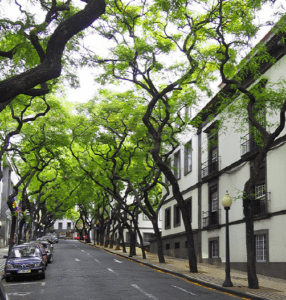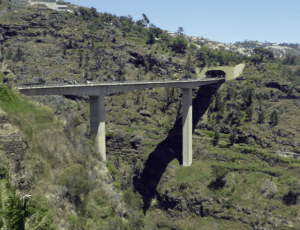Madeira was formed by volcanic eruptions and is is mountainous with peaks up to 6000.’ It is dissected by very steep sided valleys. Sides are wooded. The tops are bare with broom and heather.
Eucalyptus was introduced in the late C18th and was used in making paper. Driving through the trees there is always a strong smell of volatile oils. These unfortunately are highly flammable and have been the cause of many fires.
The eastern tip of the island is completely different. Soil is thin, vegetation low growing. There is little settlement or agriculture. Solar panels are now appearing on the hillsides as well as aerogenerators.
Flat land is at a premium and even the airport runway is built on stilts. This is described as one of the World’s most dangerous airports as aeroplanes have to swing round to come into land. it can be closed by strong winds. It is built on a platform on stilts, with the main road running beneath it.
The land rises steeply from the sea with high sea cliffs. Any beaches are black sand. The Atlantic Ocean is very clear.
Most settlement is around the coast, usually at valley mouths. The houses surrounded by small terraced gardens climb up the hillsides.
Traditionally houses are white with orange pantile roofs Many are surrounded by a plot of land, used to grow crops for family use and to sell at market. The dark volcanic soil is very fertile.
Every settlement has a small market but the biggest and best is Mercado dos Lavradores in Funchal with its flowers, fruit and Vegetable and fish markets. This is the place to see women in native costume selling flowers.
Churches were funded by the wealth from Sugar cane and later Madeira. They are traditionally white buildings with dark basalt corners and frames and coloured tile roofs. Many have splendid Baroque interiors and walls covered with traditional azulejos tiles.
One of the largest displays of Azulejos tiles is found in Monte Palace Gardens.
A lot of EU money has been used to improve roads in Madeira. Many of the old roads were narrow ledges cut out of the side of the hill with no safety barriers and many tight bends. Journey times were slow. New roads have been built with bridges spanning the valleys and tunnels through the hillside. In places there are so many tunnels you don’t see the scenery…
The main streets through towns are wide and often lined with trees, Jacarnada and the lovely red flowered African Tulip tree being particularly popular. Pavement are traditionally made from small pieces of black basalt and white limestone, often arranged as patterns.
There are several attractive small public gardens in Funchal as well as the large showcase gardens like the Botanic Gardens, Palheiro and Monte Palace Gardens, growing endemic Madeiran flora as well as plants from the rest of the world. Imported plants include the exotic Strelitzia or the bird of paradise plant, which grows across the island and is a popular cut flower.
Agapanthus is found growing wild along roadsides.
Every May there is a flower festival with floats and displays of flowers along the waterfront in Funchal.
All my pictures of Madeira are “here.”:http://wasleys.org.uk/eleanor/otherholidays/madeira/index.html















